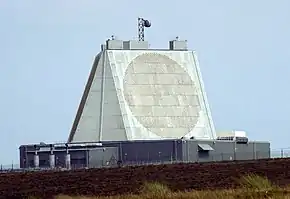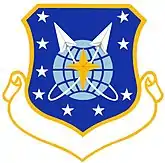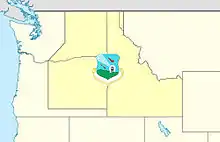9th Space Division
 | |
|---|---|
 Phased array missile detection radar at RAF Fylingdales | |
| Active | 1949–1950, 1954–1958, 1961–1968, 1990–1991 |
| Country | |
| Branch | |
| Role | Command of aerospace defense units |
| Insignia | |
| 9th Space Division emblem (approved c. 4 September 1990)[1] |  |
| 9th Aerospace Defense Division emblem |  |
| 9th Air Division emblem |  |
The 9th Space Division (9th SD) is an inactive United States Air Force organization. Its last assignment was with Air Force Space Command, being stationed at Patrick Air Force Base, Florida. It was inactivated on 1 October 1991.
History
Tactical Air Command
The organization has had several periods of activation over its lifetime. Initially established in April 1949 as the 9th Air Division (Tactical) under Fourteenth Air Force, Continental Air Command at Pope Air Force Base, North Carolina, the command had no units assigned but was to act as a headquarters over tactical units. It was inactivated in August 1950.
Air defense


It was redesignated 9th Air Division (Defense) and reactivated in October 1954 by Air Defense Command (ADC) and assigned to Western Air Defense Force (WADF) at Geiger Field, Washington, taking over control of air defense units in eastern Washington, Oregon and Idaho from the 25th Air Division (AD), after the 25th AD was realigned over the Washington and Oregon coastal area west of the Cascade Mountains. It participated in the United States Air Force collateral mission of antisubmarine warfare and administered, equipped, and trained for combat. It was inactivated in 1958 when the Spokane Air Defense Sector was established by ADC to take over its responsibilities.[1]
Aerospace and missile defense
The third incarnation of the organization began in 1961 with its reactivation as the 9th Aerospace Defense Division was associated with the North American Aerospace Defense Command by ADC, assuming responsibility for the Ballistic Missile Early Warning System, the Missile Defense Alarm System, the Space Detection and Tracking System (SPADATS), the NORAD combat operations Center, the Bomb Alarm System, and the Nuclear Detonation System.[1]
During the Cuban Missile Crisis, the division implemented an improvised missile warning system directed toward the missile threat from Cuba called "Falling Leaves." In October 1962, the SPADATS AN/FPS-49 radar at Moorestown Air Force Station, New Jersey was reoriented south and directed toward Cuba. A communication network was established with Moorestown, the AN/FPS-78 radar at Laredo Air Force Base, Texas and the AN/FPS-35 radar site at Thomasville Air Force Station, Alabama. All three stations were in turn tied into the command centers at NORAD and at Strategic Air Command. This missile detection network remained in operation until 28 November and the Moorestown and Laredo sites were returned to their normal SPADATS mission when Soviet missiles were withdrawn from Cuba. The Thomasville station, retained coverage until late December as a precaution.[2]
The division was inactivated in 1968 when its mission was elevated to a Numbered Air Force level, and transferred along with its personnel and equipment to the Fourteenth Aerospace Force on 1 July.[1]
The most recent incarnation the 9th Space Division began in 1990 when Air Force Space Command (AFSPACECOM) reactivated the organization to provide an action mechanism to "operationalize" the space launch capabilities of Eastern Space and Missile Center (ESMC) and Western Space and Missile Center (WSMC) units transferred from Air Force Systems Command to AFSPACECOM during 1990–1991. ESMC and WSMC became respectively the 45th Space Wing and 30th Space Wing within two months of the Division's inactivation in 1991.[1]
Lineage
- Constituted as the 9th Air Division (Tactical) on 7 April 1949
- Activated on 1 May 1949
- Inactivated on 1 August 1950
- Redesignated 9th Air Division (Defense) on 21 June 1954
- Activated on 8 October 1954
- Inactivated on 15 August 1958
- Redesignated 9th Aerospace Defense Division and activated on 14 July 1961 (not organized)
- Organized on 15 July 1961
- Discontinued and inactivated on 1 July 1968
- Redesignated 9th Space Division on 11 September 1990
- Activated on 1 October 1990
- Inactivated on 1 October 1991[1]
Assignments
- Fourteenth Air Force, 1 May 1949 – 1 August 1950
- Western Air Defense Force, 8 October 1954 – 15 August 1958
- Air (later, Aerospace) Defense Command, 14 July 1961 – 1 July 1968
- Air Force Space Command, 1 October 1990 – 1 October 1991[1]
Stations
- Pope Air Force Base, North Carolina, 1 May 1949 – 1 August 1950
- Geiger Field, Washington, 8 October 1954 – 15 August 1958
- Ent Air Force Base, Colorado, 15 July 1961 – 1 July 1968
- Patrick Air Force Base, Florida, 1 October 1990 – 1 October 1991.[1]
Components
|
Centers
Wings
|
Groups
|
Squadrons
|
|
See also
References
Notes
- 1 2 3 4 5 6 7 8 9 10 11 12 13 "Factsheet 9 Space Division". Air Force Historical Research Agency. 4 October 2007. Archived from the original on 30 October 2012. Retrieved 9 April 2014.
- ↑ NORAD/CONAD Participation in the Cuban Missile Crisis, Historical Reference Paper No. 8, Directorate of Command History Continental Air Defense Command, Ent AFB, CO , 1 Feb 63 (Top Secret NOFORN declassified 9 March 1996)
Bibliography
![]() This article incorporates public domain material from the Air Force Historical Research Agency
This article incorporates public domain material from the Air Force Historical Research Agency
- NORAD/CONAD Participation in the Cuban Missile Crisis, Historical Reference Paper No. 8, Directorate of Command History Continental Air Defense Command, Ent AFB, CO, 1 Feb 63 (Top Secret NOFORN declassified 9 March 1996
Further reading
- Cornett, Lloyd H.; Johnson, Mildred W. (1980). A Handbook of Aerospace Defense Organization, 1946–1980 (PDF). Peterson AFB, CO: Office of History, Aerospace Defense Center. Archived from the original (PDF) on 13 February 2016. Retrieved 28 December 2011.
- Leonard, Barry (2009). History of Strategic Air and Ballistic Missile Defense (PDF). Vol. II, 1955–1972. Fort McNair, DC: Center for Military History. ISBN 978-1-43792-131-1. Archived from the original (PDF) on 16 December 2019. Retrieved 17 January 2014.
- Maurer, Maurer, ed. (1982) [1969]. Combat Squadrons of the Air Force, World War II (PDF) (reprint ed.). Washington, DC: Office of Air Force History. ISBN 0-405-12194-6. LCCN 70605402. OCLC 72556.
- Winkler, David F.; Webster, Julie L (1997). Searching the skies: The legacy of the United States Cold War Defense Radar Program. Champaign, IL: US Army Construction Engineering Research Laboratories. LCCN 97020912.
- "ADCOM's Fighter Interceptor Squadrons". The Interceptor (January 1979) Aerospace Defense Command, (Volume 21, Number 1).
